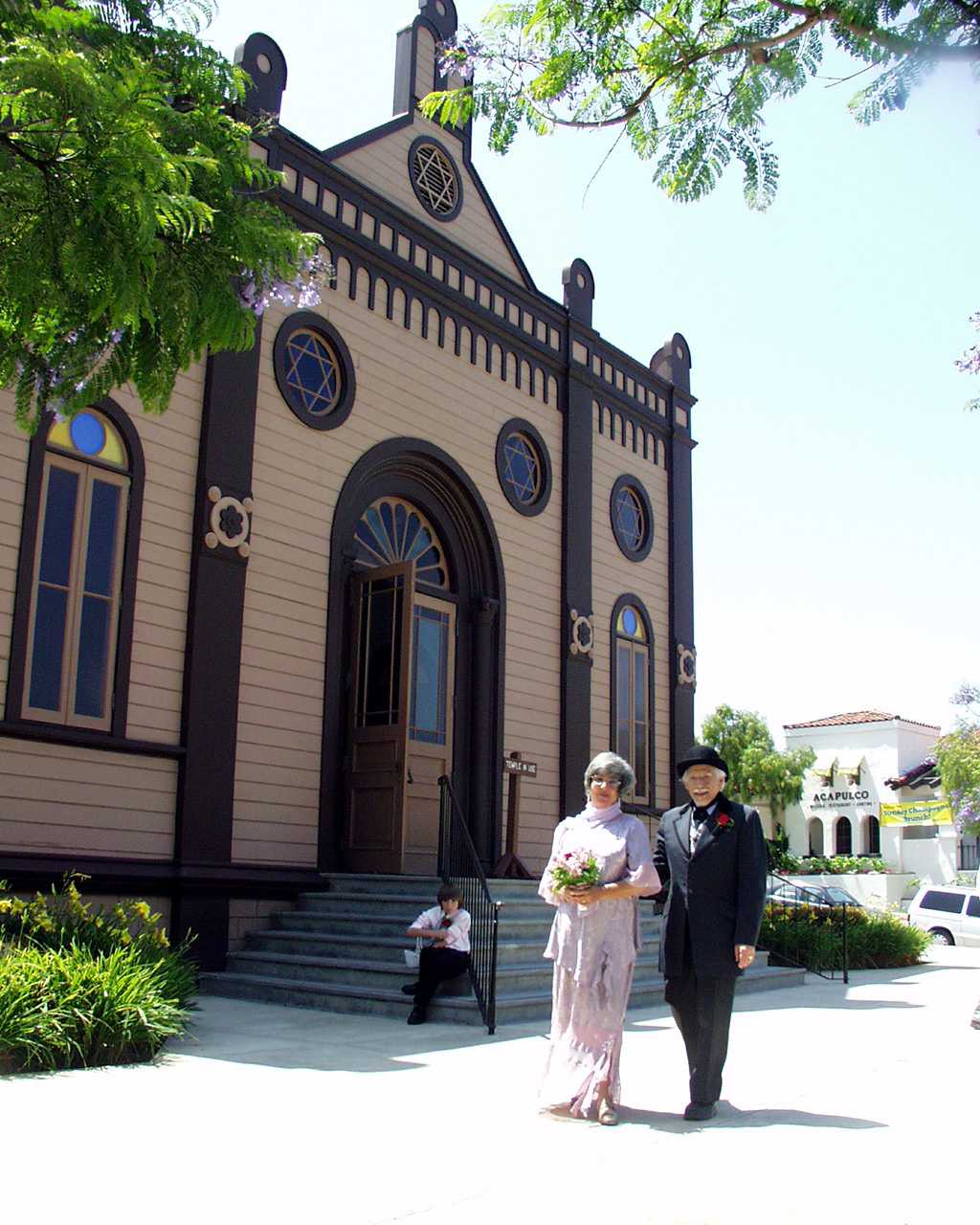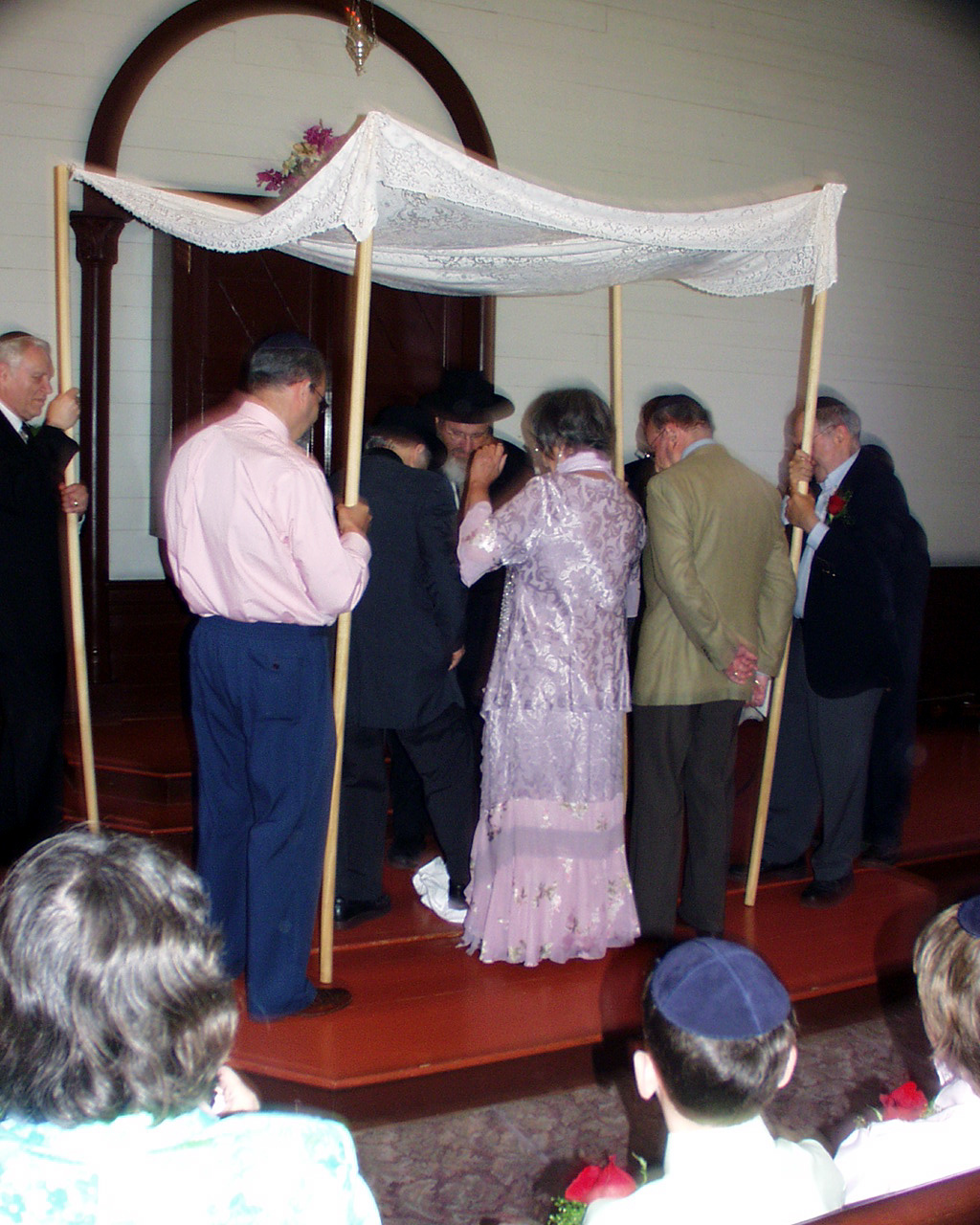|
By Donald H. Harrison
SAN DIEGO, Calif.— It was the first Jewish re-wedding
that I had ever been to, and I'd venture to say that it was also a new
experience for family members, for the rabbi, for the other guests, and most
especially for the bride and groom, Jack and Gail Forman, whose first marriage,
lasting 26 years, had ended in divorce in 1997.
 On Sunday, June 11, the Formans were under a chuppah again, the
culmination of a process of reconciliation that began three years ago.Their
recommitment—their new leap of faith—touched every romantic soul inside the
historic, Victorian-style Temple Beth Israel building at the County of San
Diego's Heritage Park. It also had many people—including the bride and
groom—searching for just the right metaphor to explain what was happening in
the Formans' lives.
On Sunday, June 11, the Formans were under a chuppah again, the
culmination of a process of reconciliation that began three years ago.Their
recommitment—their new leap of faith—touched every romantic soul inside the
historic, Victorian-style Temple Beth Israel building at the County of San
Diego's Heritage Park. It also had many people—including the bride and
groom—searching for just the right metaphor to explain what was happening in
the Formans' lives.
Rabbi
Moishe Leider of Chabad of University City took the first crack at framing
this new experience, when during the wedding ceremony, he told the bride
and groom that their marriage was a special time "not just down below here
on earth, but up in the holy realms of heaven as well. All the angels are
dancing and singing with you; they are all happy, they are all thrilled."
Leider paraphrased the Talmud as describing two kinds of marriages: those which
long before they occur are decreed in heaven, when "a divine voice comes
down from the heavens and says 'so and so should marry so and so,'" and
those marriages which are reflective of people's deeds. "Good people marry
good people and not-so-good people marry not-so-good people," Leider
explained. He added that the Talmudic sages asked how these marriages can be
told apart, and answered "the first refers to the first marriage, the
second refers to the second marriage."
 "So,"
said Rabbi Leider, "the fact is that the two of you have both of these...
This marriage is an incredible marriage. It has the qualities of the first
marriage—it is beshert (destined), it is meant to be, purely from God,
without any human intervention. At the same time, it is according to one's
deeds, a good person marrying a good person..." "So,"
said Rabbi Leider, "the fact is that the two of you have both of these...
This marriage is an incredible marriage. It has the qualities of the first
marriage—it is beshert (destined), it is meant to be, purely from God,
without any human intervention. At the same time, it is according to one's
deeds, a good person marrying a good person..."
The building in which the wedding took place had been dedicated in 1889 as San
Diego's first temple, and had been moved from downtown San Diego to the Old Town
San Diego area nearly a century later to save it from the wrecking ball.
The old Reform temple, with Stars of David on its windows, the Tablets of the
Law jutting above its roofline, and its interior refurbished with a Holy Ark and
an Eternal Light, now is perhaps the best known building among a collection of
Victorian era cottages and homes which similarly were relocated from other parts
of the county and harmoniously grouped together in a charming
setting.
Notwithstanding its Jewish decorations, the temple is used today for many
different occasions, religious and non-religious, and by many different faith
groups, according to Ranger Trish Cates, who attended the wedding as a guest of
the bridal party.
From a store in the park, Gail had purchased a lavender Victorian-style dress to
wear for the wedding, and Jack picked clothing befitting a Victorian-era
groom—the obvious analogy being that their relationship, like the old
Victorian buildings, had been given a new lease on life.
At a reception on a rolling lawn up a walkway
from the old temple, Annette
Segal, a motivational speaker and educator who helps others become teachers,
likened her friends' re-wedding to what poet and corporate lecturer David Whyte
calls "living at the fierce edges of their lives."
In a toast to the bridal couple, Segal said that "when they did this for
the first time in their star-spangled youth, with all the images of what the
other was, it was quite different than having lived through what life dishes up
to all of us and making a choice from a mature and evolved state...to spend the
rest of their lives together."
After the divorce, the couple remained in touch with each other, and
both stayed single. She worked as an English instructor and writer of books for adults studying English
as a second language, and he worked as a librarian—obviously in allied fields.
Redeveloping their relationship, said Gail,
"was not an easy road.... Communication strategies have really been helpful
and we have had support along the way. I don't think a person does this
just alone, I think he needs support, just to try."
Gail took longer than Jack to decide that perhaps they could re-marry. The
decision, she said, grew out of a realization that she didn't have to wait until
all their "problems were solved and everything was perfect" before
agreeing to marry again. Instead, she said, she could "accept it the
way it is, as a process and a goal."
So many couples today simply live together; why did they decide they
wanted to re-marry?
"When you live together without being married, there is always this out,
basically," said Jack. "You live together, but you don't work
together. You don't commit yourself to being there forever."
And why did they choose the old temple for the ceremony?
"As soon as you walk into that space, there is a feeling and a history that
is just a peaceful feeling; it kind of envelops you and you want to be part of
it," said Gail.
|

